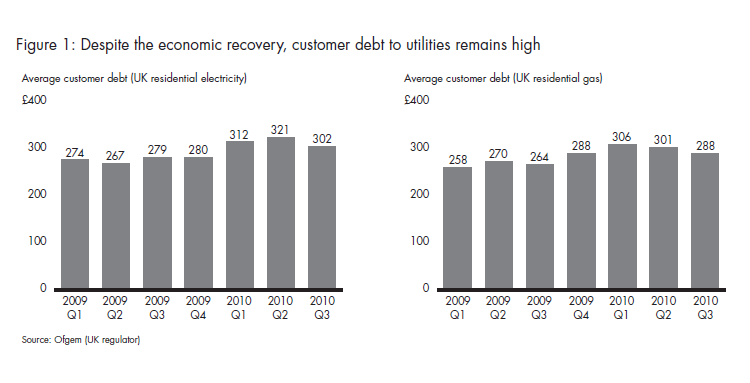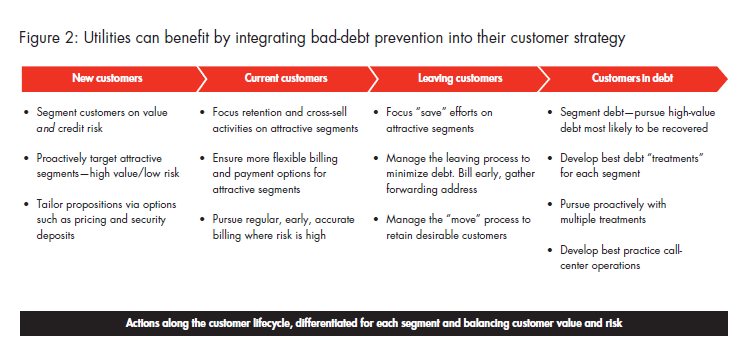Brief
Bad debt, the revenue that utilities write off because customers can't or won't pay their bills, continues to accumulate like barnacles clinging to a ship's hull and creating drag. As economic growth returns, utilities expect their cash flows to improve. But the bad-debt provisions of major European and North American utilities remain high well beyond the recession. Some utilities will write off as much debt in 2011 as they did last year, according to Bain & Company projections.
Utilities can ill afford to ignore such waste, and eliminating it can generate resources to invest in future growth. In 2010 in the UK, for example, we estimate that industry players, including EDF Energy, E.ON UK, British Gas and RWE npower, wrote off more than £800 million (almost $1.3 billion) of bad debt in aggregate. That's enough cash to build roughly 650 MW of wind farm capacity, or about 540 windmills of the 1.2 MW class.
Even though many utilities foresaw the problem early on and ramped up collection efforts significantly, bad-debt levels remain uncomfortably high. Why doesn't the wave of bad debt recede as the economy improves? In our experience, excessive levels of bad debt usually result from three related root causes:
- Too low a management priority. Historically, utilities have not placed bad-debt prevention high on the executive agenda. In good times, utilities (and companies in other sectors like banking and telecom) tend to disinvest in the area, focusing their efforts elsewhere. This approach backfires in recessionary periods when utilities need management focus and investment to control the rising tide of bad debt.
-
Not a significant part of the customer strategy. While companies in some other sectors, particularly financial services and telecom, rely on a segmented approach to managing customers in arrears, many utilities still rely on a standard, one-size-fits-all approach to tackle bad debt across all customer segments. Typically, when utilities develop a customer segmentation strategy or make tactical customer decisions, they tend to focus more on how to increase customer numbers, avoid the worst customer complaints or reduce the cost to serve customers (by reducing average handling times, for instance). Few utilities take the credit risk of customers sufficiently into account.
In fact, most debt-prevention activity kicks in very late in the cycle, when collections teams are limited to "mopping up" and collecting what they can. Often, these collections teams operate in silos, mostly disconnected from other customer activity. However, actions taken (or not taken) earlier in the customer lifecycle can determine how much customer debt builds up and will ultimately be written off. When utilities acquire high-risk customers with poor credit histories, when they offer terms and conditions inconsistent with customer risk profiles or when they manage key interactions like home/business moves sub-optimally, they increase the risk of future bad debt.
- Inconsistent execution levels. Often, utilities underestimate the execution challenge required to prevent bad debt. It is a multi-faceted area, both data intensive and analytically complex, and requiring continuous triage and process improvement. Credit assessment, for example, requires a core of skilled practitioners, competent in credit screening and risk management. Front-end and back-office operations typically involve large teams and require highly disciplined operational management, as well as effective people, team and supplier management skills. In addition, debt managers must consider broader customer and brand issues, as over-zealous collection activity can harm the brand. The low priority placed on credit management can mean these teams are often starved of sufficiently skilled resources to consistently execute effectively.

An integrated approach to reducing bad debt
So how can utilities overcome the bad-debt issue? The answer to this question may seem like straightforward performance improvement. In fact, reducing bad debt requires change at a more fundamental level. It first requires elevating bad-debt prevention to a higher priority on management's agenda—in good times and bad. The next step is fully integrating debt prevention into a utility's end-to-end customer strategy. This requires taking debt-prevention actions much earlier and varying the approach across different customer segments.

Make reducing bad debt a top priority
Some utilities have started to elevate bad-debt prevention. Facing a mountain of bad debt, one European utility recently identified bad-debt reduction as one of its top five priorities. Management communicated that across the organization, and all executives and relevant managers now have a specific bad-debt reduction target in their 2011 performance goals. The utility's leadership team also recognized that managing bad debt provides valuable professional development for its high-potential managers, since it offered a chance to hone analytical and performance-improvement skills and to manage large teams onshore and offshore. Reducing bad debt offers those managers an opportunity to have a material impact on the value of the business.
Integrate bad-debt prevention into the customer strategy
The second step is to fully integrate bad-debt prevention into customer strategy. That means taking action to avoid bad debt along the entire customer lifecycle and tailoring those actions for each customer segment. The tactical first steps typically include ensuring all new customers are properly credit screened, or assessing customers to ensure that efforts to bring in cash are not wasted on the highest-risk customers who most likely won't pay anyway. Utilities increasingly use external credit agency data and scores as well as internal payment history to screen customers in this way. Over time, utilities should embed credit risk as a key factor in all customer acquisition and management decisions.
An effective way to integrate debt prevention into customer strategy is to add risk as a criterion for customer segmentation. Utilities are increasingly using improved segmentation to focus their efforts on the most attractive, high-value customers and to make the right customer decisions. Adding credit risk into the segmentation means the focus shifts to winning and retaining high-value and lower-risk customers—and away from the highest-risk customers.
Using this bifocal lens allows the utility to make more effective decisions, based on value and risk, throughout the customer lifecycle:
- Whom to target for acquisition (higher value/lower risk) and whom to de-prioritize? For example, avoiding or further screening the smallest SME customers in verticals where credit risk is high, such as some retail sub-segments.
- How and where to price differentially? What terms and conditions and propositions to offer customers? A utility might choose to request security deposits and direct debits from riskier customers (where appropriate), while offering more flexible payment options to high-value/low-risk customers.
- How to serve customers with different needs? Lower-risk customers can be offered more flexible billing options while more regular billing or prepaying might better suit riskier customers.
- Where to invest in and apply technology? Installing smart meters in the premises of potential bad payers can make pre-payment easier to implement.
- Where to chase debt the most aggressively? A utility can more closely monitor high-risk debtors versus lower-risk customers.
- How much effort to put into retaining or renewing customers? Instead of operating blind, a utility can seek to renew lower-risk customers and avoid wasted effort trying to prevent higher-risk customers from leaving.
In the financial services sector, the best companies already follow a similar approach. Leading credit card companies, for example, thoroughly vet potential new customers based on their expected lifetime value and risk. To assess risk, they use multiple metrics—past credit history, current "balance sheet" (loans and assets), employment status, income, demographics, past credit applications—with more recent activity carrying the most weight. They then place customers in a specific segment, which determines whether they are accepted as a customer and what credit they will be offered. They regularly update their view on a customer's value and risk and take action accordingly, for example, by changing credit limits on credit cards, offering new products or loans or chasing harder for repayments. Credit card companies also factor in macro-economic risk, including modeling scenarios that assess the impact of a recession on the riskiness of the customer base.
Utilities have not yet reached this level of sophistication in managing customer risk. But to move further in the right direction, a good starting point can be what we call a "debt X-ray"—a data-driven assessment of the key causes of bad debt. The "X-ray" penetrates deep into the current debt book to identify the root causes across customer segments and processes. Armed with this granular level of insight, utilities can then construct a program to reduce the level of write-offs. A typical X-ray includes:
- A thorough assessment of write-offs over the last five years to identify the bad debtors and the root causes for high bad debt, such as business bankruptcies, customers moving without a forwarding address or billing problems caused by the utility.
- Regression or other analysis to determine the customer segments with the highest propensity for debt (for example, smaller companies versus corporate customers, tenants versus homeowners, private tenants versus social tenants).
- A risk analysis of the current customer base based on external credit scores, payment history and demographics.
- A deeper understanding of the debt prevention/collection processes and behaviors along the full customer lifecycle—as well as a clear sense of the potential gaps relative to benchmark performance.
Balancing priorities
Changing the approach to bad debt at such a fundamental level can deliver substantial results, but it takes time. A utility must build the right value-risk segmentation for its customer base and create an analytical team to continually refresh the customer data and analysis.
To make the system work over time, the utility also needs to put in place processes and incentives to ensure the right decisions are made along the customer journey, based on the value and risk segmentation.
While the integrated approach described above can pay medium-term dividends, the pressing need for shorter term results at most utilities means that the collections engine must continue to rev as well, or in some cases, may even need to be kick-started. Utilities can take a focused and systematic approach to collections if they: (1) rapidly segment the existing debt book to determine "collectability" levels and the size of the prize; (2) set realistic stretch targets; (3) cascade incentives linked to these targets to the collections frontline, especially the collections agents; (4) set up and tightly manage initiatives to deliver the targets such as call-center dialer campaigns, letter campaigns, targeted field visits and tighter management of external collection agencies; (5) track performance weekly and make adjustments where necessary; and (6) continuously monitor effectiveness and evolve the collections approach.
Utilities do not have to settle for high customer debt. While this is an enormous issue for the sector, it's a problem most utilities can fix, especially if they balance collections with the larger goal of de-risking their customer base. High debt levels are an onerous burden for utilities, but they also represent a major financial opportunity. Rather than leave money on the table, utilities can find ways to make good on bad debt—right through the business cycle.
Patrick Manning and Tim Polack are partners in Bain's London office.

